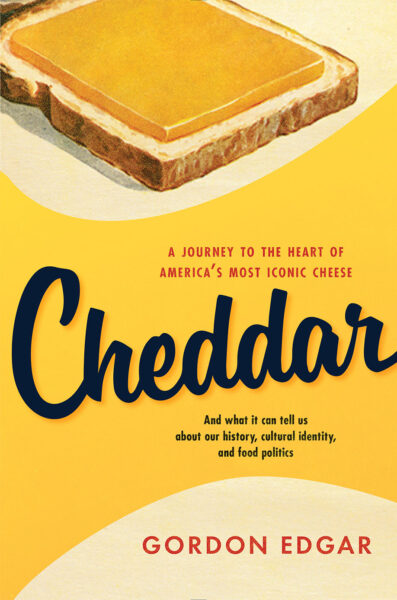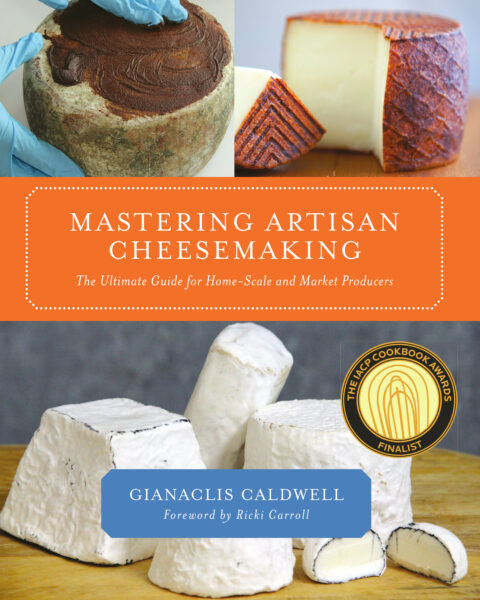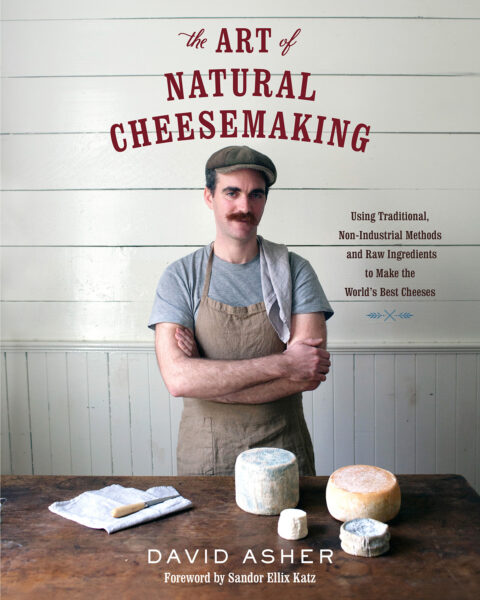Tracing the History of Cheddar with Cheesemonger Gordon Edgar

Cheddar is the world’s most ubiquitous and beloved cheese. You can find it nearly everywhere from macaroni and mousetraps to McDonald’s and mansions. Any cheese with so many fans has a story to tell, and Gordon Edgar is just the cheesemonger to tell it.
In his book, Cheddar, Edgar traces the unexplored history of America’s most iconic cheese. Traveling across the country to conduct his research, he delves into all corners of the cheese industry, researching everything from artisan wedges to mass-produced blocks and in the process reveals what this familiar food can tell us about ourselves and our culture.
We sat down with Gordon Edgar to learn about his journey and cheddar’s fascinating history, and hope you enjoy the Q&A below.
For more from Edgar listen to his interview on Vermont Public Radio.
A Conversation with Gordon Edgar
Chelsea Green: OK, let’s dispense with the suspense and cut to the chase: What state has the best, or perhaps most distinctive, cheddar in the US?*
Gordon Edgar: Trying to get me in trouble right off the bat … thanks! I do think Vermont has the most regionally-distinctive style. Vermont cheddars can be so intensely bitter and minerally that they define what the word “sharp” means to folks who grow up in the Northeast. But there are great cheddars in almost every cheese-producing state. Wisconsin, New York, California, Iowa … they can all be proud.
Editor’s note: An acceptable response. Please proceed.
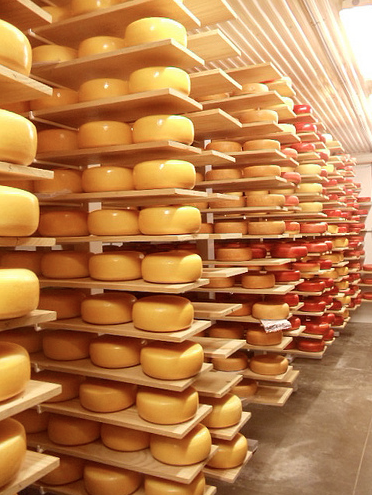 CG: What is cheddar? Is it Velveeta or is it a clothbound wheel aged in a cave? How can it be both?
CG: What is cheddar? Is it Velveeta or is it a clothbound wheel aged in a cave? How can it be both?
GE: Defining “cheddar” is much harder than it sounds. Some would argue it has to be made around the region of Cheddar Gorge, England. Others refer to parts of the process: Are the curds “cheddared” (stacked on top of each other to release more moisture)? Are the curds milled? Is it clothbound or plastic-wrapped?
The trajectory of cheddar – similar to the trajectory of most food produced in the United States – is one of efficiency. A clothbound cheddar is amazing, but flawed, since it loses weight during the aging process. Every bit of moisture loss can be seen – in a society that prioritizes profit – as money lost. The attempt to transform milk as efficiently as possible to food meant that technological advances prioritized this and not flavor, tradition, or who could produce this cheese. Velveeta is not cheddar, but this “Pasteurized prepared cheese product,” came out of this trajectory — put in motion by the Williams cheddar factory of 1851 – that led to processed cheese. One of the fascinating things I came across in researching this book were old recipes for processed cheese which called for aged cheddars to be mixed with young cheddars (and emulsifiers) so that the processed cheese would have some familiar flavor.
But the real definition for cheddar? In the US it is defined by these technical factors: the minimum milkfat content is 50 percent by weight of the solids, and the maximum moisture content is 39 percent by weight. Not very romantic, is it?
CG: What are some of the common mistruths and misunderstanding about cheddar that you, an experienced cheesemonger, had to unlearn as you embarked on research for this book?
GE: I have a list:
- “Cheddar is the most popular cheese in the land.” False, though true for a long time.
- “England invented it and America cheapened it.” Kind of true, but not totally.
- “Certainly America never exported it, except maybe recently to Asia.” False. Totally and completely false.
- “Today’s 40-pound block was a precursor of Velveeta.” False.
- “Traditional clothbound cheddar went extinct in America.” True, but more complicated than I thought.
- “Vermont cheddar and Wisconsin cheddar are very different.” True, but more out of tradition than necessity.
- “’Cheddaring’ defines cheddar. Always has, always will.” False.
- “The cheddar factory built in New York in 1851 was the country’s first cheese factory.” Controversial and depends on the definition of “factory.”
- “There would be controversies about what could be called ‘true cheddar.’” True, but duh.
- “Cheddar will tell us something about our food system.” Well, geez, I hope so since I decided to spend a couple of years figuring out what it has to say.
CG: Cheddar has been allegedly eclipsed by another cheese in recent years as the most consumed cheese in the US. What is that cheese, and why is it now number one? And, what can each of us do in order to put cheddar back on top?
GE: Though it was Number One for about 150 years, mozzarella recently took the crown away from cheddar. If you question that, go take a look in your grocer’s freezer section and check out the frozen pizzas.
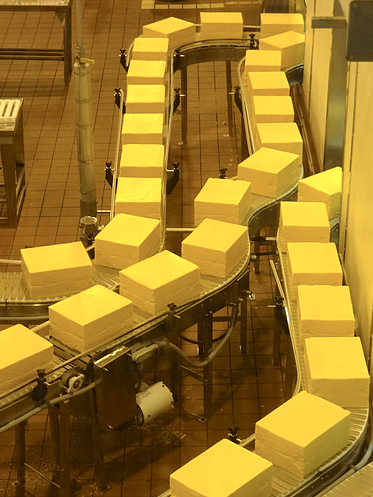 CG: You talk a lot in the book about the cheesemaking process. Is it true that cheese was made in some of the world’s first “factories”? Why did cheddar-making move off of the farm, and when and where did that happen?
CG: You talk a lot in the book about the cheesemaking process. Is it true that cheese was made in some of the world’s first “factories”? Why did cheddar-making move off of the farm, and when and where did that happen?
GE: The factory production model of cheddar was pioneered by the Williams family of Rome, New York, in 1851. Of course a “factory” in 1851 is very different from a factory in 2016, but the idea was that by bringing all the milk to a central location to be made into cheese, the farmer could be freed to farm and the cheesemaker could develop a better food. In a historical development that parallels the way that other foods and artisan products became industrialized, the factory model took off. This led — generally speaking, over the course of 150 years — to the priority of the cheesemaker becoming efficiency over distinct flavor.
Factory production of cheddar also took cheesemaking from being a woman’s job, one of many that the farmer’s wife had to perform, to being a male one. It wasn’t until the cheese renaissance of the 1970s and 80s (which we are reaping the fruits of today) that women returned to the make room.
CG: How does today’s American cheddar differ from cheddars made today in England, or even early American cheddars?
GE: Cheddar was once a wheel with a semi-porous rind that was made on a farm from the milk of the farmer’s cows. Nowadays, most cheddar made anywhere, not just in the US or UK, is made in 40- or 640-pound plastic-sealed blocks in factories that bring in milk from their regional farms. Some cheddar is still made the original farmstead way, and the biggest difference between that and cheddar from 150 years ago is in the development of consistent cheese cultures and understanding of food safety. Put simply, even very “traditional” cheesemakers today have a better understanding of how what they do affects what will happen to the cheese.
CG: You make note in the book that two of the best-known block cheddar makers — Cabot and Tillamook – are agricultural cooperatives. Is this a coincidence, or is there something about this model that allows them to keep a certain heritage alive and well?
GE: I think it’s clear that the cooperative model has allowed relatively smaller farms, from specific regional areas, to survive in a way they probably would not have if they were not organized as cooperatives. Both co-ops marketed their cheese as high quality and regionally distinct, and managed to survive through the eras when the cheese market became dominated by large, nation-wide corporations.
CG: Now that you’ve answered these questions, we have one more. With the new Star Wars film soon to be released, can you explain the role Wookey Hole plays in the evolution of cheddar? And, as a reminder, kids may be reading.
GE: I think you have to read the book for this story! Suffice it to say that Wookey Hole is a town in England’s West Country where this cave-aged brand of cheddar is made.
* Note to readers – Chelsea Green Publishing, the publisher of Cheddar is based in Vermont. So, the only correct answer to the first question is Vermont. No pressure, Gordon.
Recent Articles
Introducing…your new favorite brunch dish! This whole broccoli frittata is packed with fresh, wildcrafted flavors that are bound to help you start your day off on the right foot. The following is an excerpt from The Forager Chef’s Book of Flora by Alan Bergo. It has been adapted for the web. RECIPE: Whole Broccoli Frittata…
Read MoreWondering where to forage for greens this spring? Look no further than hedges, which serve as natural havens for wild greens and herbs! The following is an excerpt from Hedgelands by Christopher Hart. It has been adapted for the web. Food from Hedges: Salads and Greens Let’s start by looking at all the wild foods…
Read MoreThere’s a whole new world out there when it comes to koji. It doesn’t matter if you’re making bread, cheese, or ice cream, koji helps you pump up the flavor! Growing Koji in Your Own Kitchen Koji, the microbe behind the delicious, umami flavors of soy sauce, miso, fermented bean sauce, and so many of…
Read MoreWhether you’re looking to replace your end-of-the-day cocktail, relax before bed, or want something new to add to your tea, this non-alcoholic mocktail syrup base will do the trick. Delicious and all-natural, take a sip of this nightcap mocktail and feel your troubles melt away. The following is an excerpt from Herbal Formularies for Health…
Read MoreWant to enjoy bread without worrying about gluten? With Einkorn bread, a light bread with the lowest glycemic index, you can still enjoy all of the delights of bread. without any of the allergic reactions! The following is an excerpt from Restoring Heritage Grains by Eli Rogosa. It has been adapted for the web. Einkorn…
Read More

